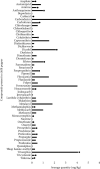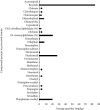Pesticide Residues and Unauthorized Dyes as Adulteration Markers in Chilli Pepper and Tomato
- PMID: 36684413
- PMCID: PMC9859701
- DOI: 10.1155/2023/5337150
Pesticide Residues and Unauthorized Dyes as Adulteration Markers in Chilli Pepper and Tomato
Abstract
To assess the contamination of processed chilli pepper and tomatoes, a report over the past four decades since the establishment of the Rapid Alert System for Food and Feed (RASFF) was retrieved and analysed. Out of the 887 notification reports assessed for eligibility, 446 were found regarding chilli pepper and tomato contamination. This study identified India as the country of origin with the highest number of reported cases relating to chilli pepper contamination. Italy and Türkiye were the countries with the highest number of reported cases regarding the exportation of adulterated tomatoes to other countries according to the RASFF report. Unauthorized dyes such as Sudan I, III, IV, orange II, rhodamine B, and para red were reported to have been detected in either chilli pepper or tomato in the supply chain. Almost all unauthorized dyes in this study were found to be more than the range (0.5 to 1 mg/kg) of the detection limit of Sudan dye and other related dyes using analytical methods set by the European Union. Unapproved pesticides by the European Union (EU) found in this study were acetamiprid, chlorothalonil, chlorpyrifos, dimethoate, methomyl, monocrotophos, omethoate, oxamyl, and thiophanate methyl. The present study indicates the persistence of chilli pepper and tomato contamination with harmful dyes and pesticide residues despite the ban on the use of certain chemicals in the food chain.
Copyright © 2023 Edward Ken Essuman et al.
Conflict of interest statement
The authors declare that there is no conflict of interest regarding the publication of this paper.
Figures








References
-
- Robson K., Dean M., Brooks S., Haughey S., Elliott C. A 20-year analysis of reported food fraud in the global beef supply chain. Food Control . 2020;116, article 107310 doi: 10.1016/j.foodcont.2020.107310. - DOI
-
- Leuschner R. G., Hristova A., Robinson T., Hugas M. The Rapid Alert System for Food and Feed (RASFF) database in support of risk analysis of biogenic amines in food. Journal of Food Composition and Analysis . 2013;29(1):37–42. doi: 10.1016/j.jfca.2012.09.004. - DOI
-
- Bouzembrak Y., Marvin H. J. Prediction of food fraud type using data from Rapid Alert System for Food and Feed (RASFF) and Bayesian network modelling. Food Control . 2016;61:180–187. doi: 10.1016/j.foodcont.2015.09.026. - DOI
-
- Lüth S., Boone I., Kleta S., Al Dahouk S. Analysis of RASFF notifications on food products contaminated with _Listeria monocytogenes_ reveals options for improvement in the rapid alert system for food and feed. Food Control . 2019;96:479–487. doi: 10.1016/j.foodcont.2018.09.033. - DOI
-
- Drabova L., Alvarez-Rivera G., Suchanova M., et al. Food fraud in oregano: pesticide residues as adulteration markers. Food Chemistry . 2019;276:726–734. - PubMed
LinkOut - more resources
Full Text Sources
Miscellaneous

